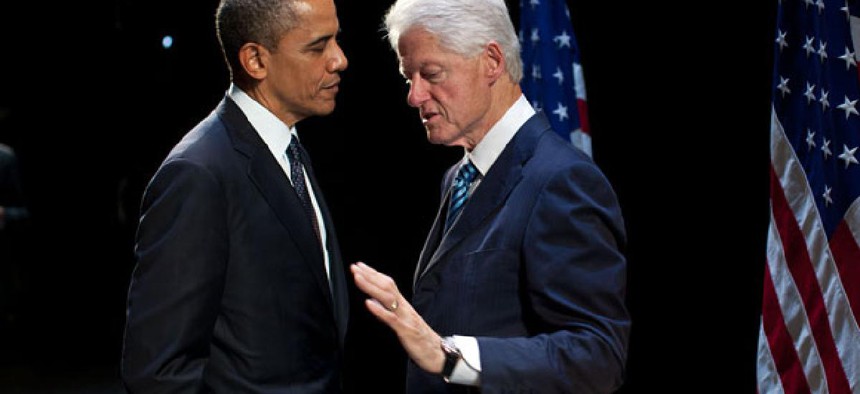The Second-Term Jinx
Ike, Nixon, Reagan, Clinton—presidents historically fumble the end of an eight-year term. With a hostile Congress, Obama faces a similar fate.
Pretend for a moment that you are President Obama, his chief of staff, his counselor, or another top adviser. The question before you is how to avoid the fate of so many other second-term presidencies. Dwight Eisenhower’s final four years were marred by a recession, Richard Nixon’s by Watergate. Ronald Reagan had the Iran-Contra scandal. Bill Clinton had Monica Lewinsky and the impeachment saga that followed. For George W. Bush, it was the unraveling of the war in Iraq. Bad things seem to happen during second terms in the White House. Beyond the obvious—don’t do stupid, illegal, or ill-advised things—how do you make the most of your final four years?
Obama realizes he is unlikely to have the political and legislative advantages he enjoyed during his first two years in office, when he had large majorities in the House and Senate—at different points, the Democrats held 59 and 60 seats in the upper chamber. That was not enough to do whatever he wanted but enough to get a lot done; Obama was in about as strong a position as any recent president has been. He and congressional Democrats were able to pass an economic-stimulus package, health care reform, and the Dodd-Frank financial-reform law. A climate-change bill even made it through the House. Whether you agree with these pieces of legislation or not, they were big deals. But they were also major drivers in the creation of the tea-party movement and the electoral beating that Democrats sustained in 2010. Democrats lost 63 House seats and control of that chamber; they lost six seats in the Senate, sliding from 59 to 53.
Because of the 2010 losses, 2011 and 2012 were less legislatively productive for Obama. Having just 53 seats in the Senate when it usually takes 60 votes to pass important measures is a major hurdle. In the House, holding Democrats together in such a polarized environment is not as hard as it used to be, but attracting Republican defectors is tougher than ever.
Public perception of the Affordable Care Act, Obama’s signature first-term accomplishment, is largely out of his hands now. History will be the judge. Although Dodd-Frank is a very important piece of legislation, most Americans don’t have a strong opinion about the complex set of financial reforms. In short, Obama’s first term is past tense.
Democrats picked up two Senate seats in November, giving them 55, and they gained eight House seats. But the legislative outlook is only marginally better for Obama. Only noncontroversial measures or those that Republicans consider to be in their political self-interest are likely to emerge from Congress this year or next. Immigration reform may fall into the latter category.
Although no one knows what will happen in next year’s midterm elections, a few outcomes are probable. Let’s say Democrats lose a few Senate seats but not the six that Republicans need to recapture control. And let’s say change will be minimal in the House, which is pretty much sorted out (93 percent of Republican House seats are in districts won by Mitt Romney; 96 percent of Democratic seats are in Obama-carried districts). The GOP has some strong preseason advantages in the Senate, where Democrats have more seats in play than Republicans, 21 to 14. Seven of the Democratic seats are in states that Romney carried, while only one seat held by a Republican is in an Obama state (Susan Collins in Maine). Still, Republicans seemed to have big advantages going into the 2012 Senate races, but for a variety of reasons they didn’t pay off.
So, just for the sake of argument, let’s say Republicans pick up two to four Senate seats, shaving the Democratic advantage to 53-47 or 51-49. In the House, let’s suppose that net changes will be limited to single digits, nowhere near the 17 seats that Democrats need to capture a majority. Under that scenario, given Washington’s highly polarized political environment, it’s hard to see how Obama can move major legislation through Congress. His last two years in office are likely to look more like his middle four years than his first two. How can he avoid that fate?
In the wake of what economist Sid Jones calls the longest, deepest, and most widespread downturn since the Great Depression, the most plausible course for the next few years is economic growth. That could work to Obama’s benefit, particularly if the public associates the improvement with his policies.
Legislatively speaking, much is possible but little is probable. Tax reform, for example, is a concept that many Democrats and Republicans embrace in theory and hope to achieve in this Congress, but actually working out a deal for the first time since 1986 (the last major tax-reform bill) would be incredibly difficult. A president has something close to a free hand only in foreign policy. Indeed, Obama has arguably been most successful in that international arena in which Congress has little say. But in the absence of a war, it’s hard for a president to make a major foreign policy mark (although Reagan and George H.W. Bush both received credit for helping to end the Cold War).
Every second-term president becomes consumed by the question of how his presidency will be remembered. For Obama, other than a pivot toward foreign policy and hope that the economy improves, it’s not obvious what he can count on to shape his legacy.
This article appeared in the Saturday, April 6, 2013 edition of National Journal.



